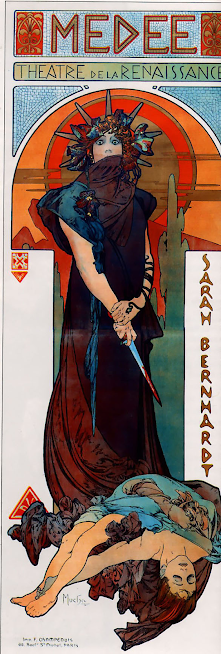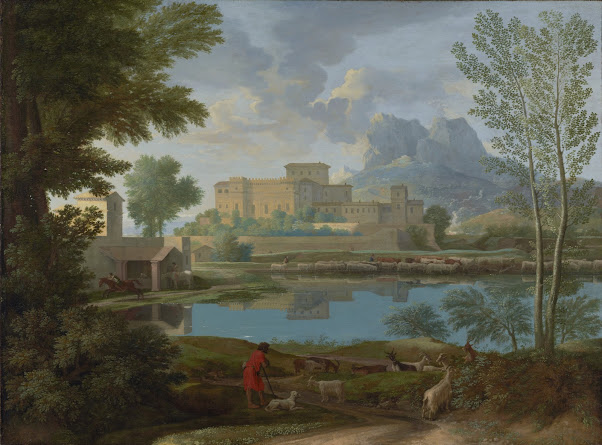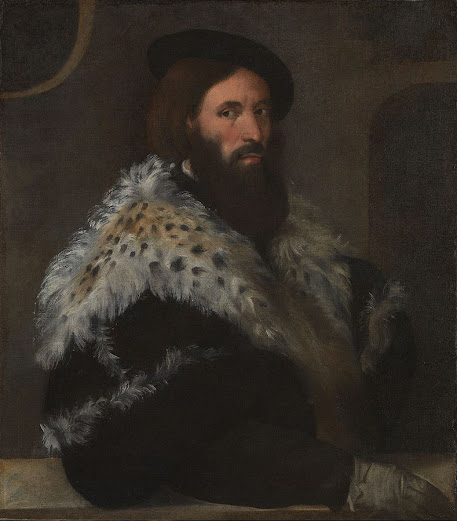The Romantic Era of art includes some of the most well-known advancements in style. Here, with Poster for Medea we see one of the artists who pioneered the poster, now a staple of our culture. Specifically, this is the Art Nouveau style, or "New Art". Art Nouveau is known for it's sweeping, organic curves, just like we can see in the bottom left of the poster with the dress of the character played by Sarah Bernhardt.
We can see the trademark 2D form of the characters, inspired in part by Japanese wood prints making their way to Europe. This distinctive look would remain popular into future forms of art. Also, the colors and tones used are in the typical Nouveau fashion, using darker tones and pigments and relying more on contrast and outlines to differentiate between shapes.
I enjoy this poster, and I noticed a lot of Mucha's other works as well, for the fantastic use of 2D character design. Mucha seems to create a storied character for each frame, and better yet they each seem unique. Most of the works I have looked at thus far for this class have featured astonishingly unrecognizable faces, if they were to be put in a crowd.
Historically, Art Nouveau is one of the first styles of art that seems to have a vested interest in looking appealing. I say that loosely, but there's no doubt it was incredibly influential and a sharp break from the thus far traditional use of art for portraiture, biblical stories, and history. The rising star of photography and the heaps of famous biblical works remaining from previous centuries left those roles filled, at least more so than before.

The Casa Batlló in Barcelona, Spain was one of the more famous of the architectural designs of Antoni Gaudí. The design featured rounded front awnings, a tower bulb and interspersed colorful roof tiles and masonry.
We see front and center the desire of Art Nouveau to alter its boundaries. The lower floor windows and have an organic, seemingly twisting effect, with railings to match. This led some of the people of Barcelona to call it the House of Bones, combined with the off-white main color.
Personally, this also tickles my fantasy brain because this is precisely the place that I would say holds rare tomes and an appropriately kooky shopkeep to pass on bits of madness and advice.
The unevenly sloped roof and colorful, winding front yields for this house a good few tourists and onlookers. The house was originally constructed in 1877, but only took on it's distinctiveness from 1904-1906, when Gaudí was hired to renovate it. A number of architects have touched it up and made minor alterations since then. The photo is from 2015.
(Casa Batlló, Antoni Gaudí, 1904-1906, Barcelona)
(The Stonebreakers, Gustave Courbet, 1849, location unknown)
Realism is a style quite contrary to the fantastic 2D depiction of Art Nouveau. The Realist style, as proffered in The Stonebreakers, depicts scenes of everyday laborers and daily happenstance. Usually focusing on human struggles, the Realist style sticks to a 3D form and varying levels of photorealism. Like Art Nouveau, Realist art tends to adopt a warmer color palate and darker tones. The Stonebreakers, pictured above, is a scene in which a young boy and an old man work together to break apart rocks in the way of a road. This labor was often reserved for chain-line workers or the poor citizens just scraping by. This was a common theme of realist works.
(Nighthawks, Edward Hopper, 1942, New York City(?))
The Realist piece
Nighthawks by Edward Hopper is one of the defining American contributions to the world art scene. Made from details taken from several inner-city diners, the painting is reminiscent of Impressionist works from earlier in the century. However, it sits firmly in the Realist style of painting because of the subject matter of everyday people doing every night things. The idea that everyday scenes were worthy of recording was the very core of Realism, and thus motivated the capture of scenes such as these. The soft, bright, blank yellow of the inner walls of
Nighthawks personally irks me, but it does make the idea of a bored and tired worker procrastinating heading home that much stronger.
The Realist and Art Nouveau styles use similar palates and techniques to display drastically different messages. Art Nouveau focuses on the eye-catching, and Realism on the honest depiction of an archetypal daily situation. I prefer the memorable characterization of the Art Nouveau style, but I can appreciate the emotions and reality held close to the metaphorical heart of Realism. Both of these styles are so monumentally influential on modern art that they're impossible to simply dismiss. We are entering the full-fledged bloom of art with these, and I didn't even get to cover the Romantic or Impressionist styles. Until next time, enjoy the great works.






This comment has been removed by the author.
ReplyDeleteI really enjoyed your Art Nouveau - Realism Blog. Since Art Nouveau is one of my favorite art styles, my preference gravitates toward it; the long, curved, organic lines in the Art Nouveau architecture, posters, and illustrations are unrivaled.
ReplyDeleteThe Stonebrakers by Gustave Corbet 1849 is an oil on canvas painting that was housed in Gemaeldegalerie Dresden until 1945.
Gustave Courbet omitted sentiment in this painting. The young boy and the old man are depicted in their "backbreaking" labor and leave it to the viewer to comprehend the inhumane working conditions of the working class. In my opinion, this is a monumental depiction/critique of the hardships of the peasant class in the 19th century.
The painting was destroyed along with other 154 paintings during the bombing by Allied forces in February 1945.
https://www.gustave-courbet.com/the-stonebreakers.jsp
Hayden , Great blog post on Casa Batllo it is a great piece of architecture. I lived in Europe for 4 years and made it to Casa Batllo in 2017. It's even better in person. I think it's surprising that this building was built by 7 great minds, Gaudi was the main architect but he took advice from Jujol, Rubio, Mestres, Gras, Cuadras and Font. If you ever make it to Barcelona I would highly recommend Casa Mila. Great architecture and a larger space. I also used the stoneworkers and prefer realism. I enjoy the show of hard work and the rough terrain it depicts, sad that it was destroyed but it's a great example of realism.
ReplyDelete